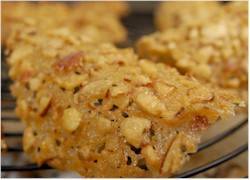|
|
| Subscribe Now |

|
|
1/3 cup (80 ml) orange juice (preferably freshly squeezed)
Zest of one large orange
1/4 cup (50 ml) Grand Marnier
1 1/4 cups (250 grams) granulated white sugar
7 tablespoons (100 grams) unsalted butter, melted
2 cups (200 grams) sliced almonds(finely chopped)
1 cup (125 grams) sifted all-purpose flour
|
|
Butter well a cookie sheet by using a pastry brush dipped in melted unsalted butter. (Make sure your cookie sheet is well greased or else the cookies will stick.) Preheat oven to 350 degrees F (l80 C) and place the oven rack in the center of the oven.
In a large measuring cup mix all the ingredients together. Let the dough rest for 10 - 15 minutes. Drop about 1 teaspoon of dough onto cookie sheet. Using a wet fork press thinly into a round shape. (Have a bowl with water close by to keep wetting your fork.) It is very important to spread the batter very thinly. The dough should be the thickness of the almond. Only put four cookies per baking sheet as they spread and have to be rolled onto a rolling pin immediately upon removing from the oven (while still warm).
Bake until golden brown, about 7 minutes. Rotate the cookie sheets front to back halfway through the baking period. While these are baking prepare your next sheet.
Remove from oven and have a rolling pin and spatula or pancake turner close by. Cool the cookies for about 30 seconds to one minute, until they can be lifted without tearing, but are still flexible. Place each cookie on top of the rolling pin and gently press to get the curved shape. Quickly do the other three cookies. If cookies become too rigid to roll, return them briefly to the oven to soften.
When cool transfer to cooling rack.
Repeat with remaining batter. These are best served the same day. They tend to lose their crispness after a day. I usually make what I need for that day and save the rest of the batter in the refrigerator until later.
Note: My cooking instructor told me a way to test to see if you have made the tuiles thin enough: After baking and cooling the tuiles, drop one to the floor. If the cookie shatters into small pieces it is thin enough. If not, then the batter needs to be spread thinner.
|
|
Tuiles, French for 'tile', are a thin and crisp cookie with a lacy texture. The name 'tuile' comes from their traditional curved shape (like a Pringle) that copies the shape of roofing tiles once used in France.
A tuile batter is made by simply mixing together melted butter, granulated white sugar, flour, freshly squeezed orange juice, a touch of Grand Marnier, and finely chopped almonds. The batter is spread into thin circles on a well buttered baking sheet and baked until golden brown. While the cookies are still hot, they are laid over a rolling pin which gives them their classic arched shape. Tuiles lose their crisp texture over time, so it is best to make them the day they are to be served. Luckily, the batter can be stored in the refrigerator up to a week so the cookies can easily be made on demand. They make a wonderful accompaniment to ice cream, sherbet or mousses.